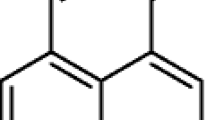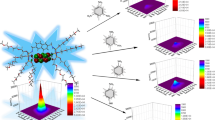Summary
A new method of analysis that incorporates many of the reagents found useful in quenchofluorometry is introduced. Since many types of non-fluorescent and weakly fluorescent compounds can be analyzed, quenchophosphorimetry is a complementary tool. This method of analysis is superior to colorimetry and fluorometry in simplicity, sensitivity and selectivity for many types of compounds. Examples of this technique are given, among which is the determination ofp-nitroaniline in the presence of carbazole,p-hydroxyacetophenone, triphenylamine and triphenylene, all being intensely phosphorescent. New types of functional group analyses for individual compounds and families of compounds should be possible with quenchophosphorimetry.
Zusammenfassung
Ein neuartiges Analysenverfahren wird vorgeschlagen, das sich vieler Reagenzien bedient, die auch zur Fluoreszenzlöschung verwendet werden. Die Phosphoreszenzlöschung bietet für viele Arten nicht oder schwach fluoreszierender Verbindungen eine zusätzliche Bestimmungsmöglichkeit. Sie ist an Einfachheit, Empfindlichkeit und Selektivität in vielen Fällen der Kolorimetrie oder Fluoreszenzmessung überlegen. Beispiele werden gebracht, darunter die Bestimmung von p-Nitranilin in Gegenwart von Carbazol, p-Hydroxyacetophenon, Triphenylamin und Triphenylen, die alle intensiv phosphoreszieren. Neue Gruppenbestimmungen in einzelnen Verbindungen und Verbindungsklassen dürften durch Phosphoreszenzlöschung möglich sein.
Résumé
On présente une nouvelle méthode d'analyse utilisant de nombreux réactifs utiles dans les mesures avec extinction de fluorescence. Comme l'on peut analyser de nombreux types de composés non fluorescents et faiblement fluorescents, la mesure avec extinction de phosphorescence constitue un outil complémentaire. Cette méthode d'analyse est supérieure à la colorimétrie et à la fluorimétrie par la simplicité, la sensibilité et la sélectivité de nombreux types de composés. On donne des exemples de cette technique, parmi lesquels le dosage de lap-nitroaniline en présence de carbazole, de lap-hydroxyacétophénone, de la triphénylamine et de triphénylène, tous fortement phosphorescents. Des analyses de groupes fonctionnels, de types nouveaux, pour les composés individuels et pour les familles de composés, seraient possibles en effectuant les mesures par extinction de phosphorescence.
Similar content being viewed by others
References
J. D. Winefordner andH. W. Latz, Analyt. Chemistry35, 1517 (1963).
S. Freed andM. H. Vise, Anal. Biochem.5, 338 (1963).
J. D. Winefordner andP. A. St. John, Analyt. Chemistry35, 2211 (1963).
E. Sawicki andJ. Pfaff, Presented at the Air Pollution Symposium, 148th National Meeting, Amer. Chem. Soc., Chicago, Illinois, September1964.
E. Sawicki, T. W. Stanley, andW. C. Elbert, Talanta11, 1433 (1964).
E. Sawicki, T. W. Stanley, andH. Johnson, Mikrochim. Acta [Wien] 1965, 178.
J. Pfaff andE. Sawicki, Chemist-Analyst54, 30 (1965).
Author information
Authors and Affiliations
Additional information
In honor of the 60th birthday of Prof.M. Jureček.
Rights and permissions
About this article
Cite this article
Sawicki, E., Pfaff, J.D. Quenchophosphorimetric analysis for conjugated compounds. Mikrochim Acta 54, 322–333 (1966). https://doi.org/10.1007/BF01217458
Received:
Issue Date:
DOI: https://doi.org/10.1007/BF01217458




